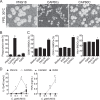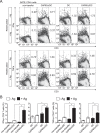Dendritic cell-based immunization ameliorates pulmonary infection with highly virulent Cryptococcus gattii
- PMID: 25644007
- PMCID: PMC4363414
- DOI: 10.1128/IAI.02827-14
Dendritic cell-based immunization ameliorates pulmonary infection with highly virulent Cryptococcus gattii
Abstract
Cryptococcosis due to a highly virulent fungus, Cryptococcus gattii, emerged as an infectious disease on Vancouver Island in Canada and surrounding areas in 1999, causing deaths among immunocompetent individuals. Previous studies indicated that C. gattii strain R265 isolated from the Canadian outbreak had immune avoidance or immune suppression capabilities. However, protective immunity against C. gattii has not been identified. In this study, we used a gain-of-function approach to investigate the protective immunity against C. gattii infection using a dendritic cell (DC)-based vaccine. Bone marrow-derived dendritic cells (BMDCs) efficiently engulfed acapsular C. gattii (Δcap60 strain), which resulted in their expression of costimulatory molecules and inflammatory cytokines. This was not observed for BMDCs that were cultured with encapsulated strains. When Δcap60 strain-pulsed BMDCs were transferred to mice prior to intratracheal R265 infection, significant amelioration of pathology, fungal burden, and the survival rate resulted compared with those in controls. Multinucleated giant cells (MGCs) that engulfed fungal cells were significantly increased in the lungs of immunized mice. Interleukin 17A (IL-17A)-, gamma interferon (IFN-γ)-, and tumor necrosis factor alpha (TNF-α)-producing lymphocytes were significantly increased in the spleens and lungs of immunized mice. The protective effect of this DC vaccine was significantly reduced in IFN-γ knockout mice. These results demonstrated that an increase in cytokine-producing lymphocytes and the development of MGCs that engulfed fungal cells were associated with the protection against pulmonary infection with highly virulent C. gattii and suggested that IFN-γ may have been an important mediator for this vaccine-induced protection.
Copyright © 2015, American Society for Microbiology. All Rights Reserved.
Figures






Similar articles
-
Dendritic Cell-Based Vaccine Against Fungal Infection.Methods Mol Biol. 2016;1403:537-49. doi: 10.1007/978-1-4939-3387-7_30. Methods Mol Biol. 2016. PMID: 27076152
-
Immunization with Antigen-Pulsed Dendritic Cells Against Highly Virulent Cryptococcus gattii Infection: Analysis of Cytokine-Producing T Cells.Methods Mol Biol. 2017;1625:327-339. doi: 10.1007/978-1-4939-7104-6_22. Methods Mol Biol. 2017. PMID: 28585000
-
A dendritic cell-based systemic vaccine induces long-lived lung-resident memory Th17 cells and ameliorates pulmonary mycosis.Mucosal Immunol. 2019 Jan;12(1):265-276. doi: 10.1038/s41385-018-0094-4. Epub 2018 Oct 2. Mucosal Immunol. 2019. PMID: 30279512
-
A Call to Arms: Quest for a Cryptococcal Vaccine.Trends Microbiol. 2018 May;26(5):436-446. doi: 10.1016/j.tim.2017.10.002. Epub 2017 Nov 2. Trends Microbiol. 2018. PMID: 29103990 Free PMC article. Review.
-
Promising whole-cell vaccines against cryptococcosis.Microbiol Immunol. 2023 May;67(5):211-223. doi: 10.1111/1348-0421.13056. Epub 2023 Mar 5. Microbiol Immunol. 2023. PMID: 36786396 Review.
Cited by
-
Cryptococcus and Phagocytes: Complex Interactions that Influence Disease Outcome.Front Microbiol. 2016 Feb 9;7:105. doi: 10.3389/fmicb.2016.00105. eCollection 2016. Front Microbiol. 2016. PMID: 26903984 Free PMC article. Review.
-
T cell responses to control fungal infection in an immunological memory lens.Front Immunol. 2022 Sep 13;13:905867. doi: 10.3389/fimmu.2022.905867. eCollection 2022. Front Immunol. 2022. PMID: 36177012 Free PMC article. Review.
-
Adjuvant Pam3CSk4 does not improve the immunization against Cryptococcus gattii infection in C57BL/6 mice.PeerJ. 2023 Jan 31;11:e14778. doi: 10.7717/peerj.14778. eCollection 2023. PeerJ. 2023. PMID: 36743957 Free PMC article.
-
Fungal Vaccine Development: State of the Art and Perspectives Using Immunoinformatics.J Fungi (Basel). 2023 May 31;9(6):633. doi: 10.3390/jof9060633. J Fungi (Basel). 2023. PMID: 37367569 Free PMC article. Review.
-
Dendritic Cells Primed with Paracoccidioides brasiliensis Peptide P10 Are Therapeutic in Immunosuppressed Mice with Paracoccidioidomycosis.Front Microbiol. 2017 Jun 14;8:1057. doi: 10.3389/fmicb.2017.01057. eCollection 2017. Front Microbiol. 2017. PMID: 28659882 Free PMC article.
References
-
- Chen S, Sorrell T, Nimmo G, Speed B, Currie B, Ellis D, Marriott D, Pfeiffer T, Parr D, Byth K. 2000. Epidemiology and host- and variety-dependent characteristics of infection due to Cryptococcus neoformans in Australia and New Zealand. Australasian Cryptococcal Study Group. Clin Infect Dis 31:499–508. doi:10.1086/313992. - DOI - PubMed
-
- BCCDC. 2011. Environmental pathogens, Cryptococcus gattii, p 112–113. British Columbia Annual Summary of Reportable Diseases 2011. BC Centre for Disease Control, Vancouver, BC, Canada: http://www.bccdc.ca/util/about/annreport/default.htm.
-
- CDC. 2010. Emergence of Cryptococcus gattii, Pacific Northwest, 2004–2010. MMWR Morb Mortal Wkly Rep 59:865–868. - PubMed
Publication types
MeSH terms
Substances
LinkOut - more resources
Full Text Sources
Molecular Biology Databases

